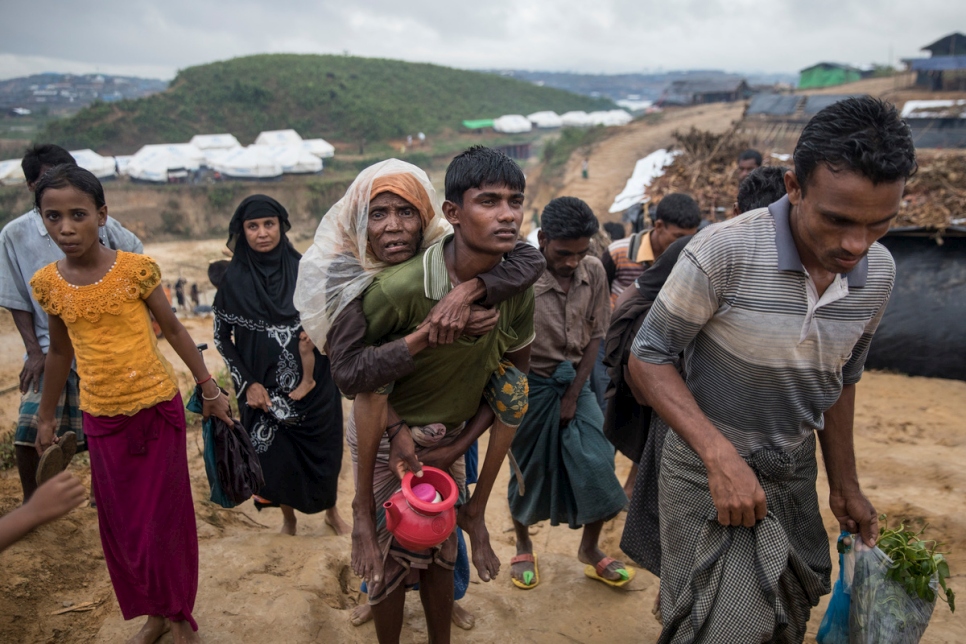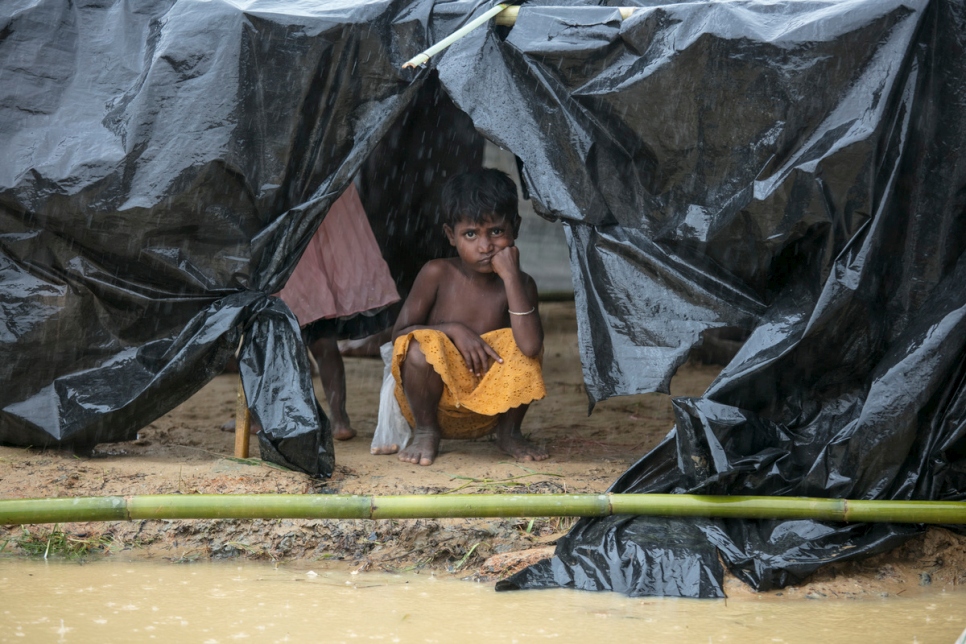Rohingya refugees and locals help newcomers in need
At a Bangladesh refugee camp, those who fled Myanmar in the 1990s give food, shelter and clothing to new arrivals in greatest need.

A Rohingya boy carries an older relative up a muddy path at the Kutupalong extension site, built on land allocated by the Bangladesh Government. © UNHCR/Paula Bronstein
KUTUPALONG REFUGEE CAMP, Bangladesh – Nasima Khatum became a refugee in Bangladesh in 1992, at the age of 10.
Now a mother, she cooks up large pots of rice over a wood fire to feed famished fellow Rohingya refugees fleeing an outbreak of violence that erupted in Myanmar in late August.
Aided by five other women volunteers, she bags up the steaming rice to feed 400–500 of the neediest children, women and men, stumbling into the area in their thousands under driving monsoon rains.
"We don’t have money, we can give time and labour."
[Even though] we came two decades before … we couldn’t just stay home, we had to do something for these new people,” she said, adding: “Although we don’t have money, we can give our time and labour to help. We will do it as long as it’s needed.”
Nasima is part of a large refugee volunteer force, supplemented by Bangladeshi citizens, mobilizing throughout two official camps in southeast Bangladesh. Working closely with local residents, and UNHCR, the UN Refugee Agency, they are drawing on years of experience and local knowledge to help respond to the largest refugee emergency the region has seen.
#Rohingya refugee children wait for aid in Bangladesh.
— UN Refugee Agency (@Refugees) September 21, 2017
Our staff is delivering life-saving aid + assistance: https://t.co/l8GdWuPA2G pic.twitter.com/FkCywIYTp3
“They are the pillar of every activity that we do, and they have been doing this from the very first day, using their own savings,” says Istiaque Ahmed, an assistant protection officer with UNHCR at Kutupalong refugee camp, which was set up in 1992 – the year Nasima arrived.
“They were collecting food and rice from door to door, then cooking in the communal kitchens … even before the donor community reacted,” he said. “The scale of the influx is unprecedented, and UNHCR provided exceptional financial support to the communal kitchens started by the refugees, in coordination with the camp authorities.”

Rohingya women serve hot meals at Kutupalong camp, where refugee volunteers support the new arrivals. © UNHCR/Paula Bronstein
At least 420,000 people have fled neighbouring Myanmar since August 24, most to south-east Bangladesh, where 387,000 of them are living in makeshift camps and spontaneous sites, many along roadsides.
New arrivals are often rain-soaked, footsore, exhausted and weakened after trekking for a week or more across rough terrain, swollen creeks and jungle. Getting aid to the most vulnerable is a life-and-death race against time for the volunteers working hand-in-hand with UNHCR.
“We target those people who are most in need – like pregnant women who have lost their husbands, elderly people and separated children,” said Mohamed Hassan, who reached Bangladesh as a child in 1991 and grew up in the camp.
Drawing on his knowledge of its maze of alleyways, he finds those on the verge of collapse at schools repurposed as emergency shelters, community centres or on the wayside. They get coupons for a nutritious free meal - typically rice, pumpkins, green plantains or lentils - which can be a lifesaver.
“We’ve lived through this ourselves, so we know what it’s like when you don’t eat even once a day,” added Mohamed, a volunteer with the men’s support group, one of several volunteer committees at Kutupalong and its sister refugee camp, Nayapara. “We are doing everything we can to help them.”

A Rohingya boy shelters under a makeshift tent at Kutupalong camp. Volunteers and UNHCR workers are battling torrential rains to build shelters on land allocated by the Bangladesh Government in Cox's Bazar. © UNHCR/Paula Bronstein
The volunteers’ help goes beyond food. In recent days, a member of the camp’s child protection committee, Dudu Mia, came across Rohingya orphans Samzida, 17, and her younger sister Yasmin, 16, weeping outside the community centre.
Dudu brought them directly to the plastic-roofed shack of Mazuma Begum, a Rohingya mother of five, who also reached Bangladesh in 1992, aged 20. Mazuma cleared a room for the sisters at the home she keeps spotlessly clean and cheerful, decorated with bright fabrics and artificial flowers.
Attackers had torched the girls’ home in Myanmar, murdered their parents and driven them out in blind panic. The sisters only found each other again at the Bangladesh border, and do not know what has become of their five siblings. Numbed with grief, they wear blank expressions and barely speak.
“They are nice, gentle girls and it was my responsibility to give them shelter,” said Mazuma, who clothed them in clean print skirts and shawls, cooks for them once a day, and watches over them. Close to tears, she added: “They are orphans, they don’t have parents … and they could be subject to sexual violence.”
"He grabbed hold of me, blessed me and wept."
UNHCR and its partners are supporting the government by mobilizing a massive aid effort to provide shelter, food and other assistance to thousands of people at the two official camps and at the informal camps and spontaneous settlements that lie beyond them.
Private donations – ranging from mosquito nets, T-shirts, buckets, cooking pots and candles to rice, lentils, vegetable oil and potatoes – are received by the manager in charge of the camp. Among camp volunteers making sure they reach those who need them most is Nur Kamal. His methodology is simple.
“Yesterday we went to the furthest part where the new refugees are arriving, which no one had reached earlier. We started giving out the donations there, walking back toward the main camp,” explained Nur, 35.
Of all the people he and his team of 30 men and women volunteers helped, he recalls the reaction of one, an old man without a family. “He had been here for several days without any assistance … The moment we gave him the food and other items, he grabbed hold of me, blessed me and wept. He said: ‘You are the first one who came here to help me.’”
Nur believes there is a lesson for the international community in the actions of the refugees at the camp. “Even if you have nothing you can still help.”
Your support is urgently needed to help the children, women and men refuges in Bangladesh. Please give now.
